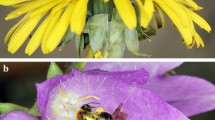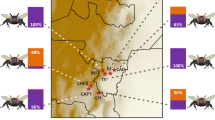Abstract
Orchid bees are an important group of specialized insect pollinators in the Neotropics. Male orchid bees are attracted by a wide range of aromatic substances often produced by flowers. Previous studies found that in some species the males change their aromatic preferences between seasons. In our study we documented seasonal changes of aromatic preferences in five euglossine bee assemblages along a 380-km-long seasonality and precipitation gradient and related them to climatic factors. We found that the proportion of species per site showing changes in their aromatic preference between seasons increased with climatic seasonality towards the south. Those species mainly belong to the genus Euglossa, subgenus Euglossa. We conclude that climatic seasonality mainly affects the orchid bees via the turnover of the aromatic substances provided by the plants. Further, we suggest that the ability to change the aromatic preference between seasons could be interpreted as a phylogenetic pre-adaptation that enabled some species to colonize climatically strongly seasonal habitats.

Similar content being viewed by others
References
Ackerman, D. (1983) Diversity and seasonality of the male euglossine bees (Hymenoptera: Apidae) in central Panamá. Ecology 64, 274–283
Ackerman, D. (1989) Geographic and seasonal variation in fragrance choices and preferences of male euglossine bees. Biotropica 21, 340–347
Anjos-Silva, E.J., Rebêlo, J.M.M. (2006) A new species of Exaerete Hoffmannsegg (Hymenoptera: Apidae: Euglossini) from Brazil. Zootaxa 1105, 27–35
Bembé B. (2004) Revision der Euglossa cordata-Gruppe und Untersuchung zur Funktionsmorphologie und Faunistik der Euglossini. PhD Thesis, Ludwig-Maximilian-Universität München, Germany
Bonilla-Gómez, M.A., Nates-Parra, G. (1992) Abejas euglossinas de Colombia (Hymenoptera: Apidae) I. Claves ilustradas. Caldasia 17, 149–172
Dressler, R.L. (1982a) New species of Euglossa II. (Hymenoptera: Apidae). Rev. Biol. Trop. 30, 121–129
Dressler, R.L. (1982b) New species of Euglossa III. The bursigera species group (Hymenoptera: Apidae). Rev. Biol. Trop. 30, 131–140
Dressler, R.L. (1982c) New species of Euglossa IV. The cordata and purpurea species groups (Hymenoptera: Apidae). Rev. Biol. Trop. 30, 141–150
Dressler, R.L. (1985) Euglossine bees (Hymenoptera: Apidae) of the Tambopata reserved zone, Madre de Dios. Perú. Rev. Peruana Entomol. 27, 75–79
Eltz, T., Whitten, W.M., Roubik, D.W., Linsenmair, K.E. (1999) Fragrance collection, storage, and accumulation by individual male orchid bees. J. Chem. Ecol. 25, 157–175
Eltz, T., Roubik, D.W., Lunau, K. (2005) Experience-dependent choices ensure species-specific fragrance accumulation in male orchid bees. Behav. Ecol. Sociobiol. 59, 146–156
Günter, S., Stimm, B., Cabrera, M., Diaz, M.L., Lojan, M., Ordoñez, E., Richter, M., Weber, M. (2008) Tree phenology in montane forests of southern Ecuador can be explained by precipitation, radiation and photoperiodic control. J. Trop. Ecol. 24, 247–258
Hijmans, R.J., Cameron, S.E., Parra, J.L., Jones, P.G., Jarvis, A. (2005) Very high resolution interpolated climate surfaces for global land areas. Intern. J. Climatol. 25, 1965–1978
Kimsey, L.S. (1982) Systematics of bees of the genus Eufriesea (Hymenoptera, Apidae). Entomology: 95. University of California Press, Berkeley
Linares-Palomino, R., Cardona, V., Hennig, E.I., Hensen, I., Hoffmann, D., Lendzion, J., Soto, D., Herzog, S.K., Kessler, M. (2009) Non-woody life form contribution to vascular plant species richness in a tropical American forest. Plant Ecol. 201, 87–99
Nemésio, A., Silveira, F.A. (2009) Orchid bees (Hymenoptera: Apidae) of the Brazilian Atlantic forest. Zootaxa 2041, 1–242
Oliveira, M.L. (2006) Três novas espécies de abelhas da Amazônia pertencentes ao gênero Eulaema (Hymenoptera: Apidae: Euglossini). Acta Amazonica 36, 121–128
Pearson, D.L., Dressler, R.L. (1985) Two-year study of male orchid bee (Hymenoptera: Apidae: Euglossini) attraction to chemical baits in lowland south-eastern Peru. J. Trop. Ecol. 1, 37–54
Ramírez, S.R., Roubik, D.W., Skov, C., Pierce, N.E. (2010a) Phylogeny, diversification patterns and historical biogeography of euglossine orchid bees (Hymenoptera: Apidae). Biol. J. Lin. Soc. 100, 552–572
Ramírez, S.R., Eltz, T., Fritsch, F., Pemberton, R., Pringle, E.G., Tsutsui, N.D. (2010b) Intraspecific geographic variation of frangrance acquired by orchid bees in native and introduced populations. J. Chem. Ecol. 36, 873–884
R Development Core Team, (2007) R (data analysis software system), version 2.11.0, R Foundation for Statistical Computing, Vienna
Roubik, D.W. (2004) Sibling species of Glossuropoda in the Amazon region (Hymenoptera: Apidae: Euglossini). J. Kansas Entomol. Soc. 77, 235–253
Steyskal, G.C. (1977) History and use of the McPhail trap. Fla Entomol. 60, 11–16
Whitten, W.M., Williams, N.H. (1991) A new species and nomenclatural changes in Gongora section Acropera (Orchidaceae). Lindleyana 6, 109–112
Zimmerman, J.K., Madrinan, S. (1988) Age structure of male Euglossa imperialis (Hymenoptera: Apidae: Euglossini) at nectar and chemical sources. J. Trop. Ecol. 4, 303–306
Acknowledgements
We thank Y. Gareca, C. Hamel, S.K. Herzog, S. Reichle, V. Sandoval, and J.Q. Vidoz for their support and advice during fieldwork. We are grateful to the Botanical Garden in Santa Cruz; the University of Cochabamba, Prometa; the municipal governments of Villa Tunari and Río Seco; and R. Clarke Gemuseus for the permission to work on their land. Furthermore, we thank B. Bembé and G. Gerlach for technical advice, C. Rasmussen and B. Bembé for the support and advice in identifying the specimens, and M. Schwerdtfeger for the baiting agents. Funding was provided by the Konrad-Adenauer-Stiftung and the DFG (Deutsche Forschungsgemeinschaft).
Author information
Authors and Affiliations
Corresponding author
Additional information
Manuscript Editor: Bernd Grünewald
Changements saisonniers dans les préférences olfactives des mâles d’abeilles Euglossine (Hymenoptera: Apidae) et leur implication écologique.
gradient climatique/précipitations/température/distribution/espèce généraliste
Jahreszeitliche Änderungen der Duftpräferenzen männlicher Prachtbienen (Euglossini, Hymenoptera: Apidae) und ihrer ökologischen Auswirkungen.
Klimatischer Gradient/ Niederschlag/ Temperatur/ Ausbreitung/ Generalist
Electronic supplementary material
Below is the link to the electronic supplementary material.
ESM 1
(DOC 42.0 kb)
Rights and permissions
About this article
Cite this article
Abrahamczyk, S., Gottleuber, P. & Kessler, M. Seasonal changes in odour preferences by male euglossine bees (Hymenoptera: Apidae) and their ecological implications. Apidologie 43, 212–217 (2012). https://doi.org/10.1007/s13592-011-0096-7
Received:
Revised:
Accepted:
Published:
Issue Date:
DOI: https://doi.org/10.1007/s13592-011-0096-7




